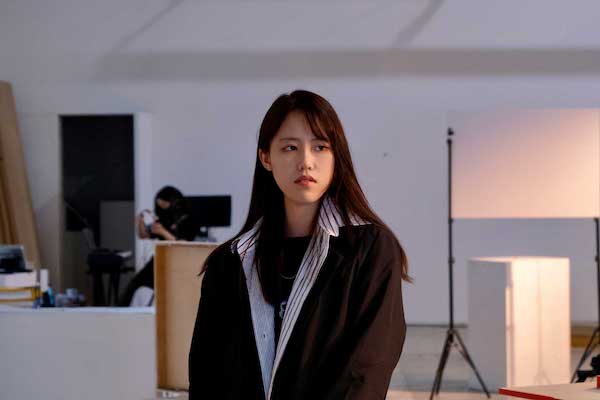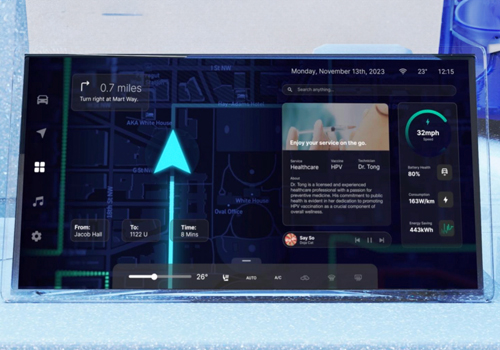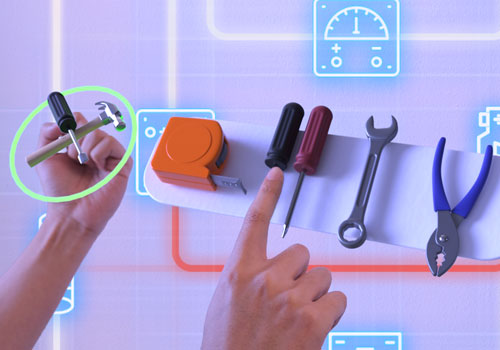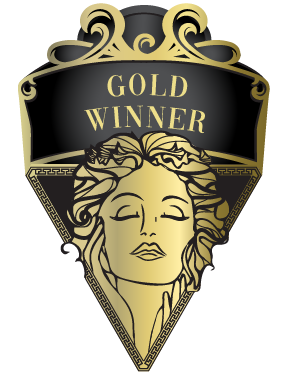
Interview
Ziyi Zhou
1 Please give us a brief bio of yourself and your design background.
As a passionate UI/UX/product designer dedicated to multi-disciplinary exploration, my design journey has spanned various projects, including user-centered design, interaction design, and industrial design. Collaborating with prestigious Fortune 500 companies, innovative start-ups, and impactful non-profits has enriched my knowledge. Holding a bachelor's degree from the Art Center College of Design and a master's degree in design from UC Berkeley, I've honed my skills to build holistic systems around products. I firmly believe in the transformative power of design to address social issues, and these academic and professional experiences have fortified my commitment to this belief.
2 What made you become/why did you choose to become a designer/artist?
Choosing to become a designer was instinctive for me. My fascination with art and design, ingrained since childhood, combined with a natural talent, led me to this path. Simultaneously, the problem-solving dimension inherent in design has always captivated me. The exhilaration of discovering creative solutions to real-life challenges is truly unparalleled. As a designer, I find immense satisfaction in transforming ideas into tangible realities, actively contributing to addressing problems for individuals and society at large.
3 Tell us more about your business/company, job profile, and what you do.
Currently employed at a tech company in the United States, I am genuinely enthusiastic about the opportunities it presents. As a vital team member, my role revolves around harnessing design skills to craft intuitive and user-centered experiences. Witnessing the contentment reflected in the smiling faces of satisfied users brings me great joy, knowing that our work contributes to the creation of value for society.
4 What does “design” mean to you?
To me, design embodies a captivating problem-solving journey that seamlessly combines creativity with logic and systems thinking. It draws inspiration from real-life needs, giving rise to solutions and innovations from ground zero to completion. Design permeates every facet of life, from the cups and tables we use to advertising posters, mobile applications, and even cutting-edge cars and rockets—all intricately woven with the creativity and dedication of designers. In its diverse manifestations, design holds the transformative power to address tangible challenges in the real world and enhance the quality of people's lives.
5 What’s your favorite kind of design and why?
My preferred design style revolves around contemplating the entire product ecosystem. I find joy in employing logical and systematic approaches that prioritize the user's needs, seamlessly blending aesthetics with functionality.
6 To you, what makes a “good” design?
A good design, to me, is human-centered, problem-solving design. Design should create value for society and have sustainable development significance. If a design looks good but does not solve any problems or reflect thoughtful thinking, it falls short of true design.
7 Describe your design style and its main characteristics.
My design style consistently considers diverse perspectives and needs of various clients. I remain attuned to and proficient in the latest design trends and tools, integrating them flexibly into my projects. By deeply understanding the user experience, I strive to create designs that meet user expectations and provide tangible value. This comprehensive design methodology allows me to adapt to industry changes seamlessly, ensuring that my designs are both contemporary and aligned with user expectations.
8 Tell us about your design process.
My design process is a systematic and collaborative approach that begins with a thorough understanding of project requirements and user needs. I conduct in-depth research and ideation, followed by prototyping to gather feedback for refinement. Collaboration is integral, involving cross-functional teams and stakeholders. Usability testing ensures a seamless user experience, and I remain adaptable to feedback, allowing the design to evolve iteratively. This approach aims to create a final product that meets aesthetic standards and aligns with functional and business objectives, delivering a solution that exceeds expectations.
9 Do you think your country and its cultural heritage has an impact on your design process?
Born in China and later receiving 5-6 years of higher education in the United States, my design and thinking are a fusion of Eastern and Western cultures. This unique blend allows me to draw inspiration from diverse perspectives, incorporating elements from both traditions into my design approach. It enriches my creativity and broadens my understanding, enabling me to create designs that resonate with a global audience while respecting and celebrating cultural diversity.
10 Congratulations! As the winner of the 2023 MUSE Design Awards, what does it mean to you and your company and team to receive this award distinction?
Winning the 2023 MUSE Design Awards is a tremendous honor for both me. This recognition signifies validation of our collective efforts, creativity, and dedication to pushing the boundaries of design excellence. It serves as a testament to the innovative spirit and commitment to quality that defines my work.
11 Can you explain a bit about the winning work you entered into the 2023 MUSE Design Awards, and why you chose to enter this project?
The winning work I entered into the 2023 MUSE Design Awards is Knovo, an AR+VR educational system in the Metaverse. I chose to enter this project because it represents a significant innovation in the field of education, addressing longstanding challenges and offering a unique solution to enhance the learning experience. The incorporation of augmented reality, virtual reality, and AI to create personalized, gamified, and immersive learning experiences sets Knovo apart, and we believed it deserved recognition for its potential impact on the education industry.
12 What was the biggest challenge with this project?
The most significant challenge I faced with this project was the need to pioneer and innovate without any prior reference or blueprint to guide us. Developing Knovo as an AR+VR educational system in the Metaverse meant venturing into uncharted territory within the education sector. I encountered the unique challenge of not only implementing cutting-edge technologies like augmented reality and virtual reality but also convincing stakeholders of their efficacy in revolutionizing traditional learning methods.
13 How has winning an Award developed your practice/career?
From my perspective as a designer, winning the award has been a transformative experience for my career and professional practice. Being honored with this award has elevated the visibility of my work within the design community and beyond. It serves as a powerful credential, showcasing my ability to think creatively, push boundaries, and deliver solutions that stand out in a competitive landscape. This recognition has instilled a new level of confidence in my design capabilities.
14 What are your top three (3) favorite things about our industry?
My top three favorite things about the design industry include its capacity for innovation and creativity, the ability to impact and improve various aspects of life through thoughtful design solutions, and the collaborative nature of the industry where diverse talents come together to create something meaningful.
15 What makes your country specifically, unique in the design industry?
Born in China and educated in the United States, my background reflects a unique blend of cultural influences that has significantly shaped my perspective within the design industry. This combination allows me to draw inspiration from diverse perspectives, incorporating elements from both traditions into my design approach. It enriches my creativity and broadens my understanding, enabling me to create designs that resonate with a global audience while respecting and celebrating cultural diversity.
16 Where do you see the evolution of design industry going over the next 5-10 years?
Over the next 5-10 years, I anticipate the design industry evolving towards even more immersive and interactive experiences, driven by advancements in technology such as augmented reality, virtual reality, and artificial intelligence. Designers will likely play a crucial role in shaping the interfaces and interactions in the increasingly digital and interconnected world.
17 If you were a student entering this industry or an aspiring MUSE Design Awards submitter, what advice would you give them?
For students entering the industry or aspiring MUSE Design Awards submitters, my advice would be to stay curious, embrace innovation, and be open to collaboration. The design field is dynamic, and continuous learning and adaptation to emerging trends are key to success.
18 What resources would you recommend to someone who wants to improve their skills in the design industry?
Resources I recommend for improving skills in the design industry include online courses and platforms like Coursera and Udacity, design conferences and workshops for networking and staying updated on industry trends, and joining design communities to connect with fellow professionals and share experiences.
19 Tell us something you have never told anyone else.
We faced internal skepticism about the feasibility of implementing AR and VR in education. Overcoming this skepticism and pushing the boundaries of traditional thinking led to the successful development of Knovo.
20 Who has inspired you in your life and why?
My mother, being a tenacious entrepreneur, has been a tremendous source of inspiration and strength in my life. Her unwavering determination and resilience have left an indelible mark on my approach to challenges and pursuit of goals. Witnessing her navigate the complexities of entrepreneurship, facing setbacks, and overcoming obstacles with grace and perseverance, has instilled in me a deep appreciation for the power of resilience.
21 What is your key to success? Any parting words of wisdom?
The key to success for us has been a combination of perseverance, a passion for creating meaningful solutions, and a commitment to continuous improvement. Parting words of wisdom: Stay true to your vision, be open to learning, and don't be afraid to push boundaries.
22 Which THREE (3) friends/peers would you nominate to participate in the next MUSE Design Awards?
Yujia Li, Jiaying Wang, Tobey Karpenko, Teena Li.
23 Do you have anything else you would like to add to the interview?
I would like to express our gratitude for the opportunity to participate in the MUSE Design Awards and showcase the innovation behind Knovo. I believe in the transformative power of design, and this recognition encourages us to continue pushing the boundaries of what is possible in the future.



